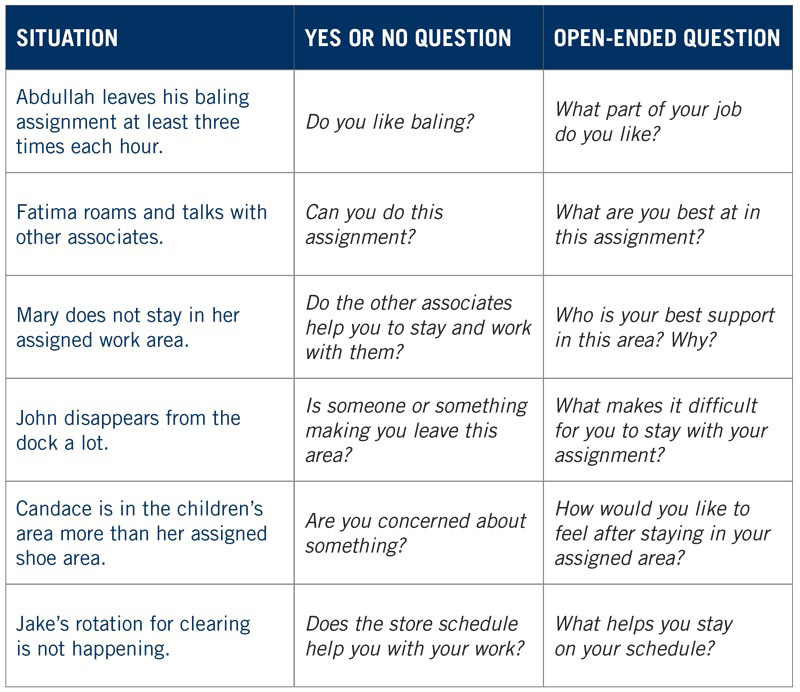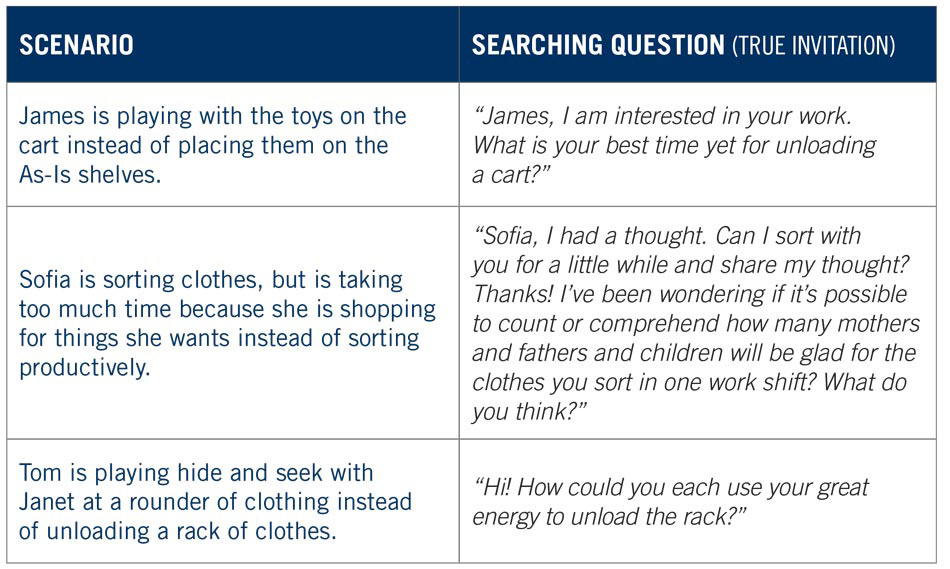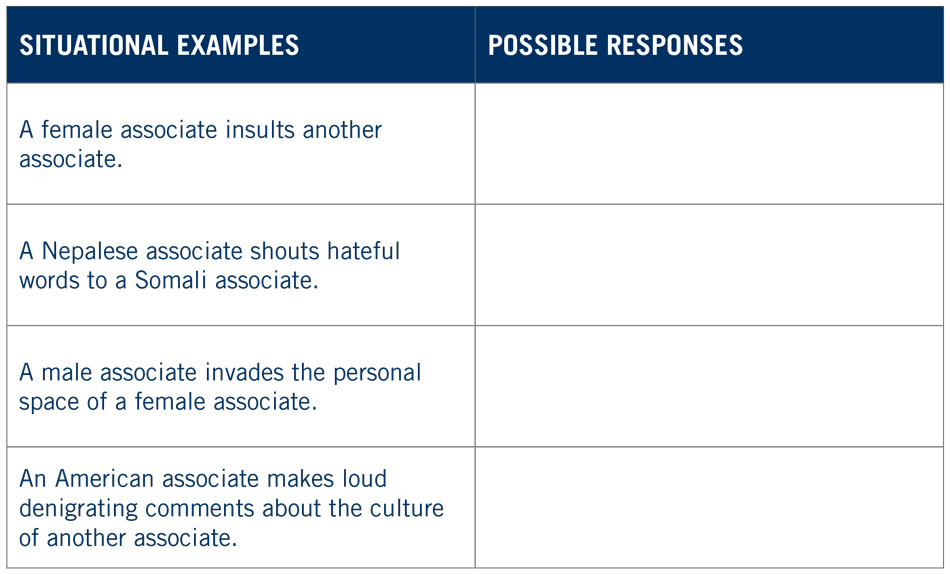Before coming to your training, please do the following:
In today’s lesson, you will continue learning how to coach associates on the behaviors in the AWARE form. Specifically, you will review and discuss techniques to help your associates learn how to work with their coworkers by (1) using open-ended questions and reasoning, (2) using searching questions and one-liners, and (3) complimenting improved behavior. As you go through this lesson’s activities, consider your associates' needs and think back to what you wrote in your learner's journal during your preparation for the lesson.
From the following list, choose and complete one or more activities that best apply to your situation.
Study the following table. Consider the questions provided for each situation. As a group, discuss the benefits of asking open-ended questions when compared to yes or no questions.

Then discuss the following questions as a group:
Take a few minutes to think individually about an associate who needs help working with coworkers. In your learner's journal write possible open-ended questions you could use to help this associate.
Assisting others to change their behavior is not easy. However, you can facilitate change by doing some of the following:
Divide into pairs and discuss the following:
After this discussion, role-play both of the following scenarios with your partner. Take turns playing the job coach trainer and the associate. Try to apply the techniques you discussed earlier in this activity during each scenario.
You notice that one of your associates had to clean up the store on his own while another associate, Krista, chose not to do anything. Talk to Krista about the importance of contributing to the workload and find a way to help her be more conscious of others in the future.
A few of your associates have told you that Tony, one of your other associates, has refused to help the lead associate with extra jobs that need to be done. Work with Tony to help him understand the situation and help him improve his behavior. Ask open-ended questions to help him.
After completing each role-play, discuss the following questions:
From the following list, choose and complete one or more activities that best apply to your situation.
Searching questions invite people to act. They help associates to see the value of their work, feel motivated to contribute to a greater cause, and to believe in their potential. Divide into small groups and take turns reading the following table aloud:

With your group members, discuss the following:
Each class member could take two minutes to think about an associate who might be struggling to work well with others. Write two to three questions you could ask next time you see this behavior. You could also share your questions with the rest of the group when you finish.
Having a quick, truthful, and memorable response to certain situations can help people change their behavior. Read the situations in the table below. Divide into pairs and come up with a one-liner response for each of the poor behaviors.

Share your one-liners with the rest of the attendees. Then discuss the following questions:
From the following list, choose and complete one or more activities that best apply to your situation.
Read the following statement by Jean B. Bingham, former first counselor in the Primary General Presidency: “How like that glorious wind can be the sincere compliment of a friend, the cheerful greeting of a parent, the approving nod of a sibling, or the helpful smile of a co-worker or classmate, all supplying fresh ‘wind in our sails’ as we battle the challenges of life! President Thomas S. Monson put it this way: ‘We can’t direct the wind, but we can adjust the sails. For maximum happiness, peace, and contentment, may we choose a positive attitude’” (“I Will Bring the Light of the Gospel into My Home,” Ensign or Liahona, Nov. 2016, 7).
This activity is comparable to speed dating (for instructions, please see the Facilitator’s Guide and Resource 1 of the “Lesson Resources” section). All class members will sit opposite one another along the length of a table. Each person should have a strip of paper in front of them on the table. One person will read what is written on the paper to his or her partner across the table. The partner will have 30 seconds to complete the sentence with a genuine compliment. After 30 seconds, pass the slip of paper down to the next pair and repeat the activity with a new sentence. After one side of the table is done reading the scenarios, switch roles and resume the activity.
As a group, discuss the following questions:
There are several ways to help associates recognize their good and bad behavior. The following activity is one such resource for job coach trainers to use with associates. Practice using the activity by following the instructions. One class member will play the job coach trainer, with the rest of the class acting as associates.
The job coach trainer will read each of the scenarios and ask the associates to give a “thumbs up” or “thumbs down” assessment of whether the people in the scenario are showing good or poor behavior.
Assess each scenario with a “thumbs up” or a “thumbs down” for behavior.
As a group, discuss the following questions:
Seek to identify a personal or business gap or need.
Spend a few minutes silently pondering what you've discussed during this lesson. Listen as the Holy Ghost helps you identify areas where you can improve. Record your impressions in your learner's journal under the question “What Lack I Yet?”
Seek ways to close the gap or develop the required talent(s) to meet the need.
With the guidance of the Spirit, create your plan of how you will improve and close the gap(s) you have identified. You may use one or more of the exercises below, your own strategy, or a combination of both. Record this plan in your learner's journal under “What Must I Do?”
After a few minutes, those who are comfortable doing so can share their impressions with the group.
Seek understanding, and then share what you learned.
During the week, focus on implementing the plan you created. Record your impressions or lessons learned in your learner's journal under “Therefore, What?” You will be given time at the beginning of next week's lesson to share your experience with the group.
“Jenny, today has seemed tough for you, but I noticed that you_________________.”
“Marcus, Jake has bothered you several times, and I appreciate that you came to tell me. Things can improve because you chose to______________________________ instead of ________________________.”
“Josh, your morning may have been difficult because I heard that Kay was teasing you. Thanks for _______________.”
“Amina, I have watched you teaching other associates to do____________________. Thank you for __________________.”
“Kirk, it was not easy to be outside today helping our customers. I really appreciate the way that you___________________.”
“Maria, I noticed that you were able to help customers and get your books shelved in a really good time. I like the way that you _____________________________.”
The following resources can help you learn more about coaching AWARE behaviors with coworkers.


